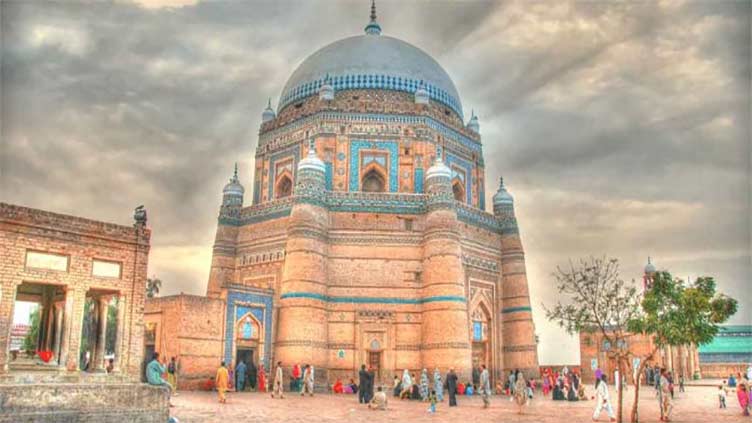Multan – The land of perennial spiritualism

Pakistan
Multan – The land of perennial spiritualism
MULTAN, (APP) - Dating back to ancient times and serving mankind, the city of Multan cherished generations in its rich archaeological and cultural heritage with historical linkages revealing secrets of the past.
Previously called “the City of Gold” and “the City of Saints”, and then recognized as the sister city of Rome back in June 2011, it stands tall among contemporaries with all its spiritual and traditional essence.
Within the radius of twenty-five miles, there have been hundreds of mausoleums of saints who preached Islam in sub-continent with a message of fraternity, love, peace, tolerance and religious harmony that also named it as ‘Madeena-tul-Olya.’
But, with the passage of time, out of hundreds shrines in the city and suburbs, many were erased or damaged due to urban expansion or development.
According to Auqaf Department, 3000 to 4000 shrines are still intact with grandeur and visited frequently by the people of different creeds for spiritual inclination.
“Most frequently visited shrines include well-known Hazrat Sheikh Bahauddin Zakariya Suhrawardi, Shah Rukn-e-Alam, Bibi Pak Daman, Shah Yousaf Gardez and some others,” said a senior official of Auqaf Department.
Bahauddin Zakariya also remembered as “Baha-ul-Haq,” was the noteworthy Sufi saint of his time following whose marvellous contribution, Multan earned metaphoric title as “Baghdad of the East.” He travelled across South Punjab to preach Islam converting thousands infidels to this great religion.
“Hazrat Bahauddin Zakariya was not only a Sufi saint but also a great social and economic reformer,” said an official of the Auqaf Department. “Thousands devotees visit his shrine that features the earliest example of blue tile work in the subcontinent.” He and Bibi Pak Daman are stated to have brought the Suhrawardiyya order of Sufism to Multan, he said.
Shah Rukn E Alam (1251-1335) was the grandson and successor of Baha-ul-Haq who continued message of his grandfather. His shrine was built by Ghias-u-Din Tughlaq in early 14th century and is a masterpiece of architecture.
Build atop a small hillock, behind the old ruins of Multan Fort, the mausoleum and its majestic dome can be seen from afar when anybody enters the city. More than 50 feet in diameter with a height of over 100 feet, the entire complex is built of red bricks and decorated with wonderful woodwork.
“Around 2000-3000 devotees visit the shrine Thursdays, Fridays and Sundays, and 1500-2000 people during other week days,” said another Auqaf Department official, Muhammad Arshad. “The department’s officials welcome visitors, offer them traditional green Chaddar to round it around their necks or heads.”
Shah Rukn-e-Alam’s grave is surrounded by graves of his descendants manifesting marvelous interior decoration art with elaborate tile work coated with the plaster material. The Auqaf department arranges annual 3-day Urs of Shah Rukn Alam’s on 5th to 7th Jamadi-ul-Awal every year.
Another revered saint is Bibi Pak Daman (1170-1262). Alaso known as Bibi Rasti, she was mother of Shah Rukn Alam and a disciple of Hazrat Bahauddin Zakariya.
She died in 1295 and was buried near to the temple of Mai Totla, one of Multan’s three pre-Islamic deities. The tomb is roughly rectangular, decorated with Multan’s signature blue and white tiles with design of the tomb appearing as a ‘flat roof.’
The mausoleum of Shah Yusuf Gardez, near Bohar Gate inside the walled city is another gorgeous example of Sufism. The mausoleum was built in 1150 AD and the mosque in its southern part by Sher Shah Suri during his tenure (1639-1655).
Shah Yousaf Gardez converted a large number of non-believers to Islam. His descendants are known as Gardezis and counted among noble families of the country. Born in 1058 in Gardez (near present-day Ghazni), he died in 1136.
In the South Eastern part of city, to the northwest of Delhi Gate, is the tomb of Shah Dana Shaheed – a disciple of great Bahauddin Zakariya (1170-1262).
According to Auqaf Department, there is very little substance available about Shah Dana Shaheed’s life and many others including Hameed-ud-Din Hakim,
Qutab-al-Qutaab, Syed Pir Sakhi Shah Hassan Parwana, Syed Hasan Khanjzee, Hazrat Shah Dana Shaheed, Abu Hassan Hafiz Jamal-ud-din called Musa Pak Shaheed, Hazrat Shah Kamal Qadari, Hafiz Muhammad Jamal Chisti Nazami, Pir Chup Wardi Waly, Mollana Hamid Ali Khan Naqshbandi. Hazrat Khawaja Awais Khagga, Pir Syed Wali Muhammad Shah (Chadar Wali Sarkar), Hazrat Sakhi Sultan and Hazrat Gul Shah whose shrines were situated at deserted locations of the district.
Thousands devotees visit these sites every year to learn from their teachings and rekindle their spiritualism.
“I have come here to pray for success of my son in intermediate examination,” said 63-year-old Ismael who had come from Toba Tek Singh to visit Shah Rukn-e-Alam’s last abode. “We come here out of respect and honor, we owe to these pious people.”
Safia Bibi, a scholar also came long way from Dera Ghazi Khan to view inspiring layout of the shrines.
“It’s typical of Suhrawadi tombs with three entrances, a western-facing Mehrab and original main entrance on the southern axis,” she remarked with joy and wonder.
Visitors continue to throng the shrines particularly those of Bahauddin Zakariya Suhrawardi, Shah Rukn-e-Alam and Shah Yusuf Gerdez round the year.
Annuals Urs are organized at prominent shrines marked by Qawwalis and Dhamal with visitors donating hundreds of thousands rupees for the shrines and the welfare of poor people. Series of lectures by renowned religious and sufi scholars are also organized to highlight services of Sufis for spreading Islam in the Sub-continent.


